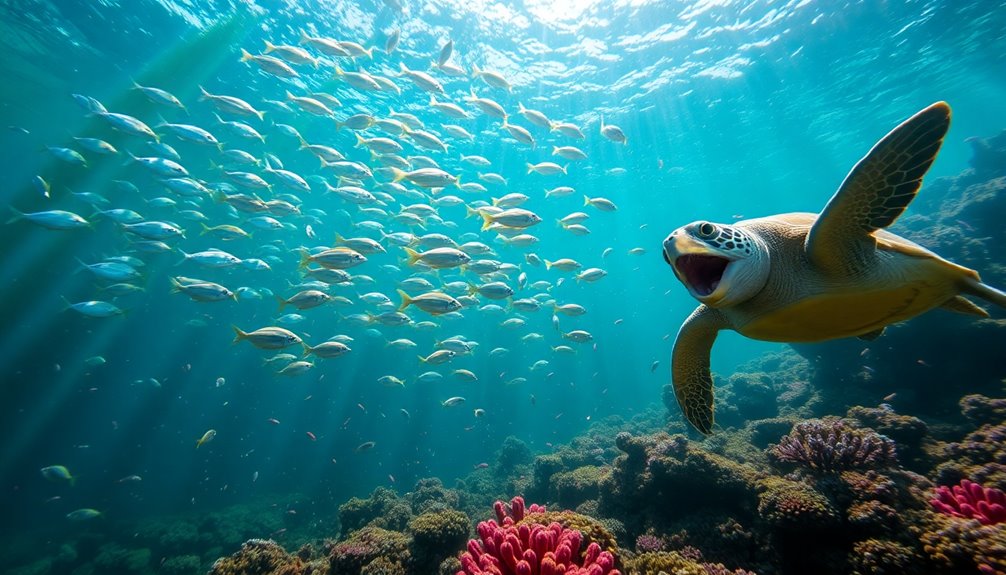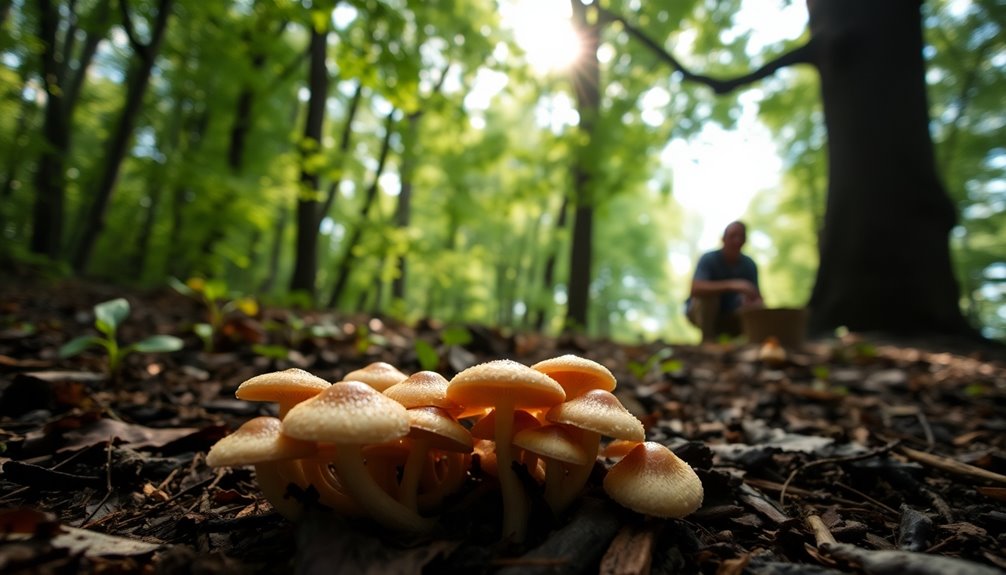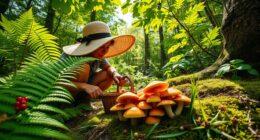Forage fish, like sardines and anchovies, primarily snack on plankton. They consume phytoplankton when they're younger and switch to zooplankton as they grow. This diet is essential, as it links them to higher trophic levels in the ocean ecosystem. By eating plankton, forage fish help transfer energy and support various marine predators. Their feeding habits adapt seasonally, responding to plankton blooms in warmer months. Unfortunately, threats like overfishing jeopardize their important role. Want to uncover more about these remarkable fish and their impact on marine life? There's a lot more to explore!
Key Takeaways
- Forage fish primarily consume plankton, including phytoplankton and zooplankton, which are essential for energy transfer in marine ecosystems.
- Younger forage fish focus on phytoplankton, while older individuals shift their diet to include zooplankton and larvae.
- Seasonal variations in plankton availability influence the feeding habits of forage fish, requiring dietary adaptations throughout the year.
- Schooling behavior enhances foraging efficiency and reduces predation risk, allowing forage fish to effectively target abundant food sources.
- Omnivorous species can adjust their diets based on food availability, showcasing their adaptability and critical role in maintaining oceanic food webs.
Overview of Forage Fish

Forage fish, such as sardines, anchovies, and herring, play an essential role in marine ecosystems. These small yet important creatures serve as primary consumers, feeding primarily on plankton, which includes both phytoplankton and zooplankton. By doing so, they form a significant link in marine food webs, transferring energy from lower trophic levels to higher ones.
As you observe these fish, you might notice that young forage fish typically consume phytoplankton, while older individuals adapt their diet to include zooplankton and fish larvae.
Forage fish often form large schools, enhancing their foraging efficiency and reducing the risk of predation while feeding in the pelagic zone of the ocean. This schooling behavior not only benefits their survival but also maximizes their role as a food source for larger predators like tuna, sharks, and seabirds.
Their presence is so essential that they're considered keystone species; declines in their populations can disrupt predator-prey dynamics, affecting the entire ecosystem. By understanding the significance of forage fish, you can appreciate how these small fish support the health and stability of marine environments.
Diet Composition and Feeding Habits
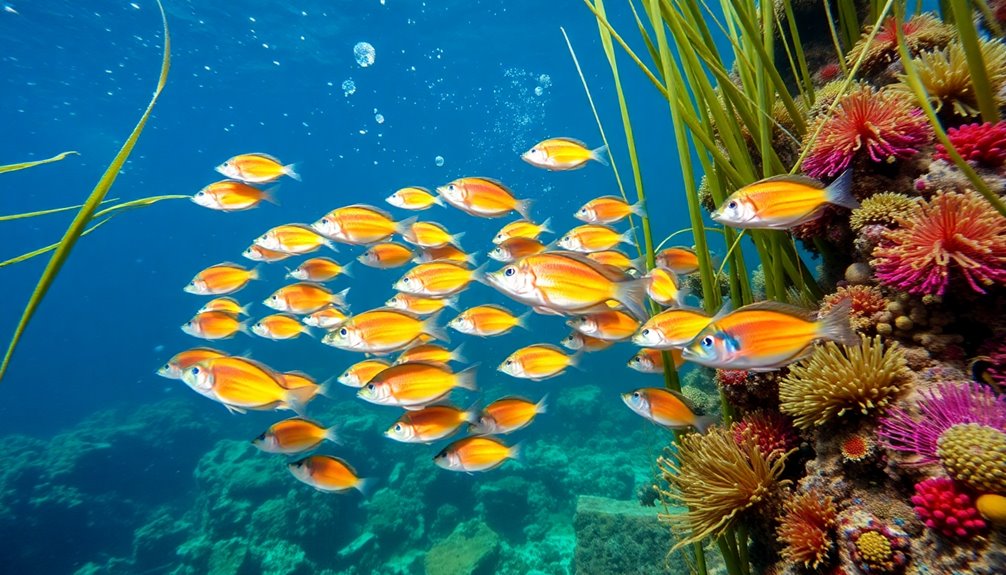
When you look at the diet composition of forage fish, you'll see they primarily feed on plankton, which includes both phytoplankton and zooplankton.
Their feeding strategies vary, with schooling behavior helping them efficiently capture food in the pelagic zone.
Plus, their diet can change with the seasons, affecting their role in the marine food web.
Primary Food Sources
Plankton forms the foundation of many forage fish diets, with these small organisms playing a crucial role in marine ecosystems. Forage fish primarily feed on both zooplankton and phytoplankton, converting these microscopic food sources into energy for larger predators.
Younger fish, like larval herring, mainly consume phytoplankton, while older individuals often shift to a diet rich in zooplankton and small fish larvae.
Specific examples include sardines and anchovies, which form large schools and mainly target copepods, krill, and other small crustaceans. These dietary habits not only provide essential nutrients but also contribute to nutrient cycling within marine ecosystems.
By transferring energy from primary producers, forage fish sustain higher trophic levels and support marine biodiversity.
Moreover, some forage fish, such as ocean halfbeaks, exhibit omnivorous behavior, consuming a mixed diet of algae, plankton, and smaller fish. Their adaptability to seasonal availability of food sources guarantees they remain a crucial link in the food web. Additionally, the health of forage fish populations is often influenced by seasonal promotions in their food availability, which can impact their role in the ecosystem.
Understanding these primary food sources highlights the significance of forage fish in maintaining the health and balance of marine ecosystems.
Feeding Strategies Explained
Understanding how forage fish feed reveals the complexity of their diets and habits. These fish primarily target plankton, relying heavily on both phytoplankton and zooplankton to meet their energy needs.
As you observe younger forage fish, like juvenile sardines and anchovies, you'll notice they primarily consume phytoplankton. However, as they mature, their diets shift toward zooplankton and small fish larvae.
One fascinating aspect of their feeding behavior is schooling. By swimming in large groups, forage fish not only enhance their foraging efficiency but also protect themselves from predators during feeding. This social structure is essential, especially when food sources are limited.
Additionally, some forage fish, like ocean halfbeaks, display omnivorous feeding habits. They adapt their diets by consuming a mix of algae, plankton, and smaller fish, depending on seasonal changes in food availability.
This adaptability allows them to thrive in varying environments, showcasing their resilience. To sum up, the diverse feeding strategies of forage fish highlight their significant role in the ocean ecosystem, as they efficiently convert primary producers into energy for larger marine species.
Seasonal Diet Variations
Seasonal variations greatly impact the diet composition and feeding habits of forage fish. As these fish grow, young individuals primarily consume phytoplankton, while older ones shift to a diet rich in zooplankton and fish larvae.
During spring and summer, plankton blooms lead to increased food availability, allowing forage fish populations to thrive. This surge enhances their feeding efficiency, which directly influences their growth rates and reproductive success.
In contrast, during colder months, food availability declines, prompting forage fish to adapt their diets. Some tropical species even exhibit omnivorous behavior, switching between carnivory and herbivory based on seasonal changes. These adaptations guarantee they maximize nutrition when resources are scarce.
The diet of forage fish is essential for maintaining the health and stability of marine ecosystems. As they serve as a key link in the food web, fluctuations in their feeding patterns can ripple through the entire system, affecting predator species and the overall balance of marine life.
Understanding these seasonal diet variations is imperative for protecting these critical populations and the ecosystems they support.
Ecological Importance in Marine Ecosystems
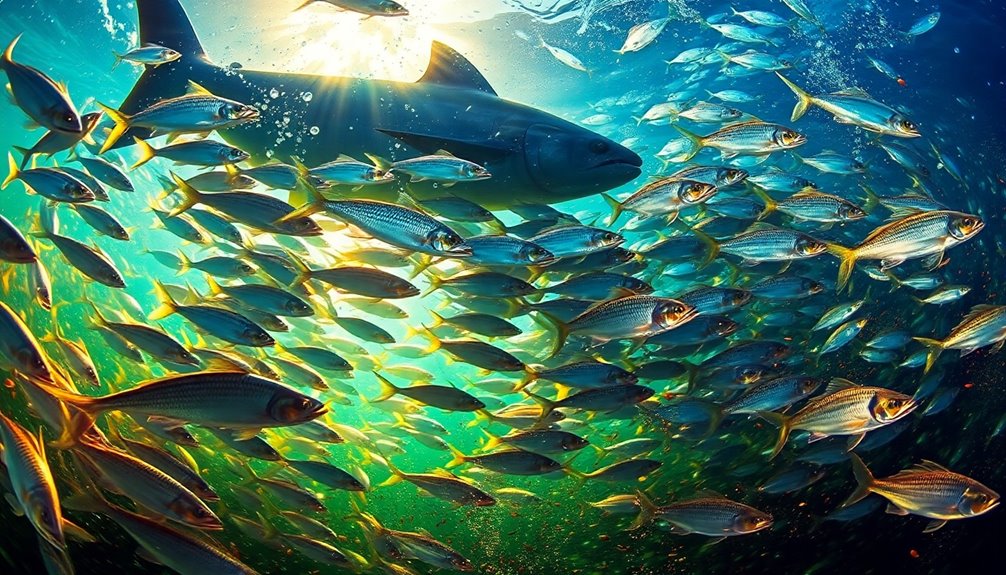
Forage fish play a pivotal role in marine ecosystems, serving as an essential link between microscopic primary producers and larger predators. These small fish primarily feed on plankton, including both phytoplankton and zooplankton, acting as significant secondary consumers. By converting this microscopic energy into biomass, they facilitate energy transfer up the food chain, supporting a variety of predator populations such as larger fish, seabirds, and marine mammals.
The ecological role of forage fish is fundamental for maintaining the stability of marine ecosystems. Healthy populations enhance marine biodiversity, allowing for a balanced ecosystem that sustains various predator species.
When forage fish populations decline, the effects can be catastrophic. You may see decreased reproductive success in predator species and increased competition for food resources, ultimately destabilizing the entire marine food web.
In essence, forage fish are the backbone of ocean health, ensuring that energy flows from primary producers to apex predators. Their presence supports not only the diverse marine life but also the overall resilience of marine ecosystems, highlighting why it's critical to protect these essential species.
Impact of Overfishing on Forage Fish
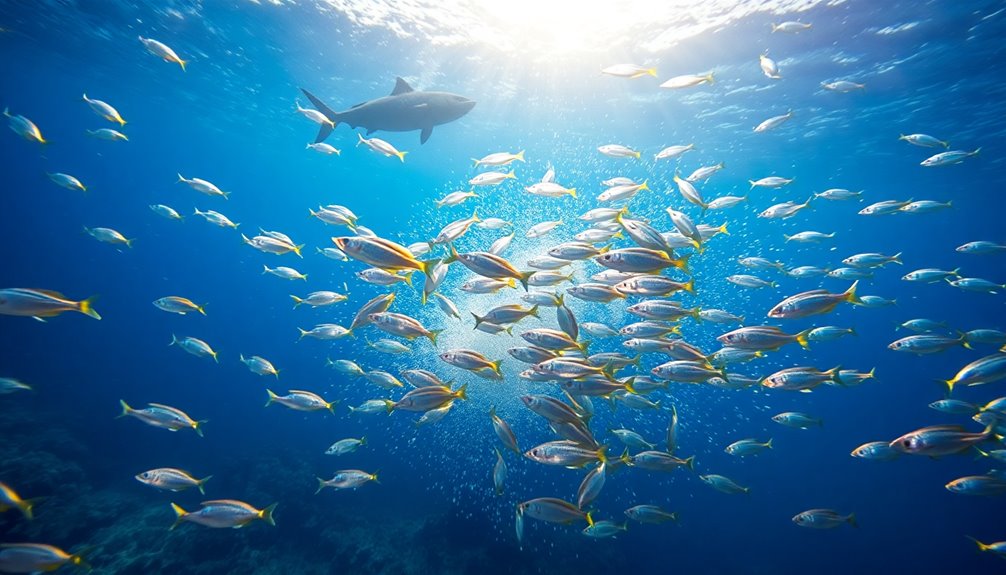
The stability of marine ecosystems relies heavily on the health of forage fish populations. When you consider the impact of overfishing, it becomes clear how fragile these species truly are. Overexploitation can lead to drastic declines in forage fish like the Peruvian anchoveta, which is essential for both local communities and the larger marine food web.
Historically, the collapse of Pacific sardine populations in the 1950s due to high fishing pressure serves as a stark reminder of their vulnerability.
Forage fish account for a staggering 37% of the global fish catch, and their decline affects not just their populations but also the predator species that depend on them for sustenance. Without adequate catch limits and effective management, we're risking irreversible damage to marine biodiversity and the health of marine ecosystems.
This jeopardizes food security for many marine species and humans alike. You need to understand that safeguarding forage fish populations isn't just about protecting a single species; it's about preserving the intricate web of life that sustains our oceans.
Role in the Ocean Food Web
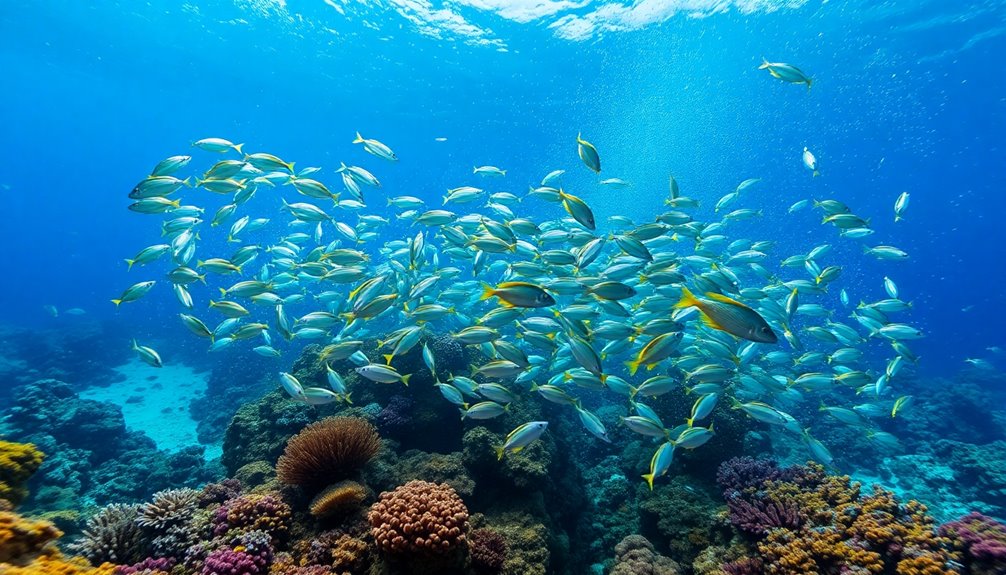
In the intricate design of the ocean food web, forage fish serve as a vital link between microscopic organisms and larger marine predators. These schooling fish primarily feed on plankton, including both phytoplankton and zooplankton, converting this microscopic energy into biomass.
Young forage fish typically dine on phytoplankton, while older individuals, like herring and anchovies, shift to consuming zooplankton and fish larvae. This dietary adaptation marks their role as secondary consumers in the marine ecosystem.
As essential players, forage fish are a primary food source for various marine predators, such as larger fish, seabirds, and marine mammals. Their presence helps maintain the stability of the food web, ensuring that higher trophic level species can thrive.
Furthermore, the health and abundance of forage fish populations directly influence the dynamics and reproductive success of these predators, underscoring their ecological importance.
Future Challenges and Conservation Efforts
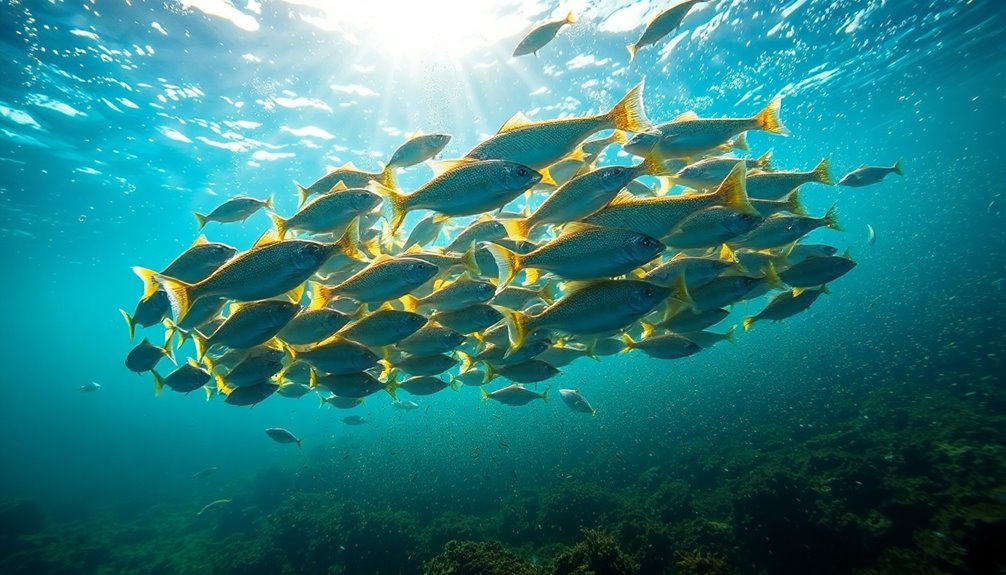
While overfishing and environmental changes pose considerable threats, addressing these challenges is necessary for the future of forage fish populations. Sustainable management practices, such as establishing fishing quotas and implementing ecosystem-based strategies, are imperative for balancing predator needs with forage fish harvest limits. These efforts guarantee the long-term health of these critical populations.
Conservation efforts are backed by research initiatives like those from the Lenfest Forage Fish Task Force, which provide the scientific data necessary for effective management policies. As the demand for forage fish in aquaculture and fishmeal continues to rise, advocacy for sustainable fishing practices becomes increasingly important. You can play a role in this by supporting initiatives that protect forage fish species.
Engaging consumers through education and awareness campaigns helps promote the importance of forage fish conservation. Making sustainable seafood choices can greatly benefit marine ecosystems and reduce the pressures on these key species.
Frequently Asked Questions
What Do Forage Fish Eat?
Forage fish primarily eat plankton, which includes both tiny plant-like and small animal-like organisms.
When you look at young forage fish, they mainly consume phytoplankton. As they grow, their diet shifts to include zooplankton and even fish larvae.
Some species, like ocean halfbeaks, mix it up by eating algae and smaller fish, too. This diverse diet not only fuels their growth but also plays a crucial role in the marine food web.
Do Forage Fish Eat Phytoplankton?
Yes, forage fish eat phytoplankton, especially during their early life stages.
You'll find that this microscopic plant material provides them with essential energy. As they grow, they start including zooplankton in their diet, but phytoplankton remains a key part.
Their survival and growth depend on the availability of this primary food source, which is influenced by environmental factors like nutrient levels and temperature.
What Does Forage Mean in Fishing?
Think of a bustling city where small shops feed larger businesses—this is how forage works in fishing.
In this scenario, "forage" refers to small fish like sardines and anchovies that serve as essential food for larger predators, such as tuna and seabirds.
These species form large schools, making them significant for energy transfer in marine ecosystems.
Understanding this relationship helps you appreciate the balance of ocean life and the need for sustainable management.
What Small Forage Fish Is Commonly Eaten in Greenland?
In Greenland, the small forage fish you'll often come across is capelin. This fish is traditionally enjoyed dried or smoked, playing a key role in local culinary practices.
Capelin's rich in omega-3 fatty acids, making it an important source of nutrition for the Inuit and coastal communities.
You'll find that capelin fishing isn't only essential for sustenance but also supports the economy and promotes sustainable marine resource management in the region.
Conclusion
In summary, forage fish play an important role in maintaining the health of our oceans. Did you know that about 70% of the fish caught worldwide are forage fish? This staggering statistic highlights their significance not just as a food source for larger marine species but also for human economies. Protecting these small yet essential fish is necessary for preserving marine ecosystems. By supporting sustainable fishing practices, you can help guarantee a thriving ocean for future generations.

